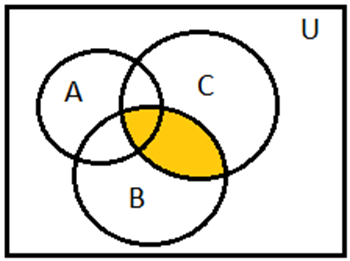Featured Posts on Lesson Plan
Mathematics Lab Activity-3 Class XI
- Get link
- X
- Other Apps
Mathematics Lab Activity-3 Class XI
Chapter - 1 | Set Theory
Activity - 3
Objective
To verify distributive law for three non-empty sets A, B and C, that is
A⋃ (B ⋂ C) = (A⋃B)⋂(A ⋃C)
Material Required
Hardboard,
thick sheet of paper, pencil, colours, scissors, adhesive.
Theory
Distributive
Law
For any
three sets A, B and C, we have :
1. A ⋃ (B ⋂ C) = (A ⋃ B) ⋂ (A ⋃ C)
2. A ⋂ (B ⋃ C) = (A ⋂ B) ⋃ (A ⋂ C)
Procedure
1. Cut five rectangular strips from a sheet of paper and paste them on the hardboard so that three of the rectangles are in horizontal line and paste the remaining two rectangles also horizontally in a line just below the above three rectangles.
2. Write the
symbol U in the left or right corner of each rectangle as shown in the figures
below. U denotes the universal set represented by the rectangles.
Fig 4.1 B ⋂ C
Observations
1. In figure 4.1 colored portion represents B ⋂ C
2. In figure
4.2 colored portion represents A ⋃ B .
3. In figure 4.3 colored portion represents A ⋂ C .
4. In figure 4.4 colored portion represents A ⋃ (B ⋂ C) .
5. In figure 4.5 colored portion represents A ⋃ B) ⋂ (A ⋃ C)
6. On measurement common colored portion in fig. 4.4 is equal to the colored portion in figure 4.5. A ⋃ (B ⋂ C) = A ⋃ B) ⋂ (A ⋃ C)
Result
Applications
The
distributive law of set operations is used in the simplification of problems
involving set operations.
VIVA – VOICE
Q. 1. What are the properties of the operations of union of two sets ?
Ans.
Operations of union of two sets have the following properties :
Q. 2. What are the properties of the operation of intersection of two sets ?
Ans. The operation of
intersection of two sets has the following properties :
Q. 3 Which set theory is used in the present day mathematics?
Ans. Georg cantor’s set theory.
THANKS FOR YOUR VISIT
PLEASE COMMENT BELOW
- Get link
- X
- Other Apps









Comments
Post a Comment